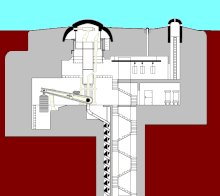Armored dome


The armored dome , also known as the armored tower , is an element of fortress construction that emerged at the end of the 19th century . The main reason for this was that artillery technology developed considerably from around 1840 :
- In 1840 the Swedish industrialist Martin von Wahrendorff succeeded in developing a rear loading system for (still smooth) cannons ready for series production. This breech- loading cannon system was soon introduced in Prussia . In 1846 Wahrendorff had a system for drawn tubes followed. Until then, the guns had rigid, rear closed (" muzzle loader ") tubes.
- Guns with rifled barrel could fire explosive long projectiles , which were set in rotation by the trains , which significantly improved the accuracy . This enabled the range to be increased beyond the core range for the first time .
- Explosive grenades (now known as high explosive grenades or HE projectiles (high explosive)) were able to “shoot short and small” in previous fortresses.
- the rate of fire (rounds per minute) of the guns increased.
- Pivot mounts improved the directivity of the guns and absorbed the recoil . From around 1897 France put the Canon de 75 mle 1897, the first real rapid-fire gun, into service. The main feature was the long return pipe .
There was therefore no longer any place within a fortified area that was no longer threatened by direct hits (“direct hits”) from the new guns . The reaction to this was the installation of bell-like stands made of chilled cast iron or cast steel in the area of the respective fortress , in which weapons were set up and which enabled the protected observation of the battlefield .
France decided to build a fortress line ( Barrière de fer ) because it had lost the Franco-Prussian War (1870/71). Large parts were bricked up; After the fortresses were completed, it was found that their walls did not withstand the new explosive shells. It came to the so-called explosive grenade crisis (French: la crise de l'obus torpille ).
Since the first construction, French technicians had tried to install guns (especially mortars ); but the masonry did not withstand the vibrations. That is why this was given up until the turn of the century.
The so-called Casemate de Bourges was first made of concrete. 'Commandant du Génie' Laurent invented it in 1885; In 1899 they were tested and modified; they contained two 75 mm guns . These were often preferred to a type with 75 mm cannons 'modèle 1905' because they were significantly cheaper. The concrete casemates were supposed to close gaps between forts and fortresses.
Armored domes could reach massive sizes. The heaviest dome of the Belgian fort Eben-Emael weighed over 400 tons. Below this dome were two cannons with a caliber of 120 millimeters. The dome could be rotated 360 degrees, which allowed the cannons to fire at almost any target within 17 kilometers.
On the other hand, such domes offered a very conspicuous target for the attacking enemy. This led to retractable armored domes, which rose above the surface of the fortress only for the immediate use of the weapon and otherwise remained completely invisible to the attacker. Typically, the weight of the dome was counterbalanced by a lever system and a counterweight to enable lifting and lowering with little force (see graphic).
Smaller domes with a periscope inside were built to observe the surroundings . In Germany, domes were used especially on the Siegfried Line and on the fortress front of the Oder-Warthe-Bogen , which were firmly embedded in concrete and therefore could not be rotated. The uninterrupted use of weapons (in this case machine guns ) was ensured by an increased number of notches , typically three out of six of these openings were used to guide a weapon.
See also
- 10.5 cm turret cannon (Switzerland)
- 10 cm tower howitzer THM9 (Austria-Hungary)
- Tourelle Galopin de 155 mm R modèle 1907
Web links
Individual evidence
- ↑ sur fortiffsere ( Memento of April 18, 2009 in the Internet Archive )
- ↑ see also French Wikipedia: Tourelle de 75 mm R modèle 1905

